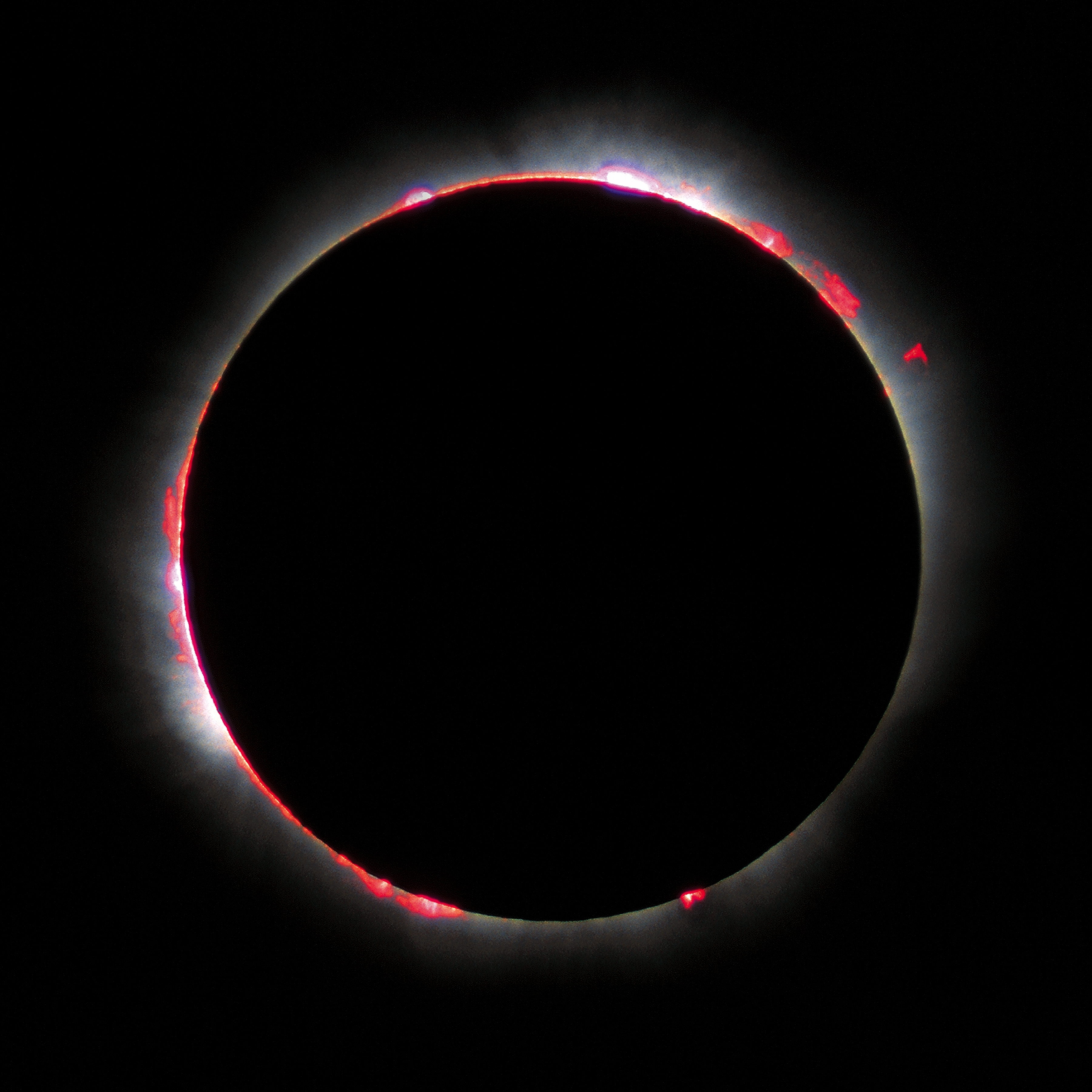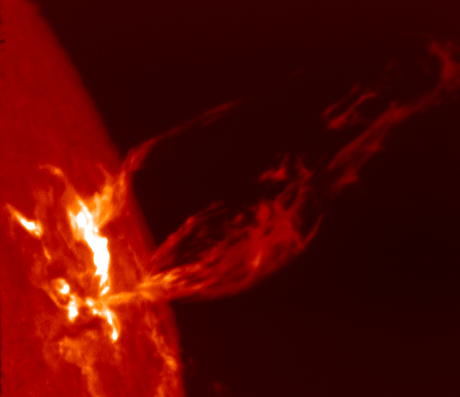|
HD 12661
HD 12661 is a G-type main sequence star in the northern constellation of Aries. The star is slightly larger and more massive than the Sun, with an estimated age of seven billion years. It has two known extrasolar planets. Properties The apparent visual magnitude of this star is 7.42, making it too faint to be viewed by the naked eye even under ideal viewing conditions. However, it can be readily observed using a small telescope with an aperture of or more. Parallax measurements of HD 12661 place it at a distance of about from the Earth, with a margin of error of ±0.2 light years. It has a stellar classification of G6 V, indicating that it is a main sequence star that is generating energy through the thermonuclear fusion of hydrogen at its core. The effective temperature of the star's outer envelope is about 5,754 K, giving it the characteristic yellow hue of a G-type star. Based on stellar models, estimates of the radius of this star range from 107% to 112 ... [...More Info...] [...Related Items...] OR: [Wikipedia] [Google] [Baidu] |
Effective Temperature
The effective temperature of a body such as a star or planet is the temperature of a black body that would emit the same total amount of electromagnetic radiation. Effective temperature is often used as an estimate of a body's surface temperature when the body's emissivity curve (as a function of wavelength) is not known. When the star's or planet's net emissivity in the relevant wavelength band is less than unity (less than that of a black body), the actual temperature of the body will be higher than the effective temperature. The net emissivity may be low due to surface or atmospheric properties, including greenhouse effect. Star The effective temperature of a star is the temperature of a black body with the same luminosity per ''surface area'' () as the star and is defined according to the Stefan–Boltzmann law . Notice that the total ( bolometric) luminosity of a star is then , where is the stellar radius. The definition of the stellar radius is obviously not stra ... [...More Info...] [...Related Items...] OR: [Wikipedia] [Google] [Baidu] |
The Astrophysical Journal
''The Astrophysical Journal'', often abbreviated ''ApJ'' (pronounced "ap jay") in references and speech, is a peer-reviewed scientific journal of astrophysics and astronomy, established in 1895 by American astronomers George Ellery Hale and James Edward Keeler. The journal discontinued its print edition and became an electronic-only journal in 2015. Since 1953 ''The Astrophysical Journal Supplement Series'' (''ApJS'') has been published in conjunction with ''The Astrophysical Journal'', with generally longer articles to supplement the material in the journal. It publishes six volumes per year, with two 280-page issues per volume. ''The Astrophysical Journal Letters'' (''ApJL''), established in 1967 by Subrahmanyan Chandrasekhar as Part 2 of ''The Astrophysical Journal'', is now a separate journal focusing on the rapid publication of high-impact astronomical research. The three journals were published by the University of Chicago Press for the American Astronomical Society u ... [...More Info...] [...Related Items...] OR: [Wikipedia] [Google] [Baidu] |
Astronomy And Astrophysics
''Astronomy & Astrophysics'' is a monthly peer-reviewed scientific journal covering theoretical, observational, and instrumental astronomy and astrophysics. The journal is run by a Board of Directors representing 27 sponsoring countries plus a representative of the European Southern Observatory. The journal is published by EDP Sciences and the editor-in-chief is . History Origins ''Astronomy and Astrophysics'' (A&A) was created as an answer to the publishing scenario found in Europe in the 1960s. At that time, multiple journals were being published in several countries around the continent. These journals usually had a limited number of subscribers, and published articles in languages other than English, resulting in a small number of citations compared to American and British journals. Starting in 1963, conversations between astronomers from European countries assessed the need for a common astronomical journal. On 8 April 1968, leading astronomers from Belgium, Denmark, Fr ... [...More Info...] [...Related Items...] OR: [Wikipedia] [Google] [Baidu] |
List Of Extrasolar Planets
These are lists of exoplanets. Most of these were discovered by the Kepler space telescope. There are an additional 2,054 potential exoplanets from Kepler's first mission yet to be confirmed, as well as 978 from its " Second Light" mission and 4,081 from the Transiting Exoplanet Survey Satellite (TESS) mission. For yearly lists on physical, orbital and other properties, as well as on discovery circumstances and other aspects, ''see ''. Nomenclature Methods of detection Specific exoplanet lists Lists of exoplanets *List of directly imaged exoplanets * List of exoplanets discovered before 2000 () * List of exoplanets discovered between 2000–2009 () * List of exoplanets discovered in 2010 () * List of exoplanets discovered in 2011 () *List of exoplanets discovered in 2012 () * List of exoplanets discovered in 2013 () * List of exoplanets discovered in 2014 () *List of exoplanets discovered in 2015 () *List of exoplanets discovered in 2016 () *List of exoplanets discov ... [...More Info...] [...Related Items...] OR: [Wikipedia] [Google] [Baidu] |
HD 12661 C
HD 12661 c is a giant exoplanet one and a half times the mass of Jupiter orbiting around HD 12661 HD 12661 is a G-type main sequence star in the northern constellation of Aries. The star is slightly larger and more massive than the Sun, with an estimated age of seven billion years. It has two known extrasolar planets. Properties Th .... References Aries (constellation) Exoplanets discovered in 2003 Giant planets Exoplanets detected by radial velocity {{extrasolar-planet-stub ... [...More Info...] [...Related Items...] OR: [Wikipedia] [Google] [Baidu] |
HD 12661 B
HD 12661 b is a giant exoplanet two and a half times the mass of Jupiter orbiting around the star HD 12661 HD 12661 is a G-type main sequence star in the northern constellation of Aries. The star is slightly larger and more massive than the Sun, with an estimated age of seven billion years. It has two known extrasolar planets. Properties Th .... References * Aries (constellation) Giant planets Exoplanets discovered in 2001 Exoplanets detected by radial velocity {{extrasolar-planet-stub ... [...More Info...] [...Related Items...] OR: [Wikipedia] [Google] [Baidu] |
Jupiter
Jupiter is the fifth planet from the Sun and the largest in the Solar System. It is a gas giant with a mass more than two and a half times that of all the other planets in the Solar System combined, but slightly less than one-thousandth the mass of the Sun. Jupiter is the third brightest natural object in the Earth's night sky after the Moon and Venus, and it has been observed since prehistoric times. It was named after the Roman god Jupiter, the king of the gods. Jupiter is primarily composed of hydrogen, but helium constitutes one-quarter of its mass and one-tenth of its volume. It probably has a rocky core of heavier elements, but, like the other giant planets in the Solar System, it lacks a well-defined solid surface. The ongoing contraction of Jupiter's interior generates more heat than it receives from the Sun. Because of its rapid rotation, the planet's shape is an oblate spheroid: it has a slight but noticeable bulge around the equator. The outer atmospher ... [...More Info...] [...Related Items...] OR: [Wikipedia] [Google] [Baidu] |
Correlation And Dependence
In statistics, correlation or dependence is any statistical relationship, whether causal or not, between two random variables or bivariate data. Although in the broadest sense, "correlation" may indicate any type of association, in statistics it usually refers to the degree to which a pair of variables are '' linearly'' related. Familiar examples of dependent phenomena include the correlation between the height of parents and their offspring, and the correlation between the price of a good and the quantity the consumers are willing to purchase, as it is depicted in the so-called demand curve. Correlations are useful because they can indicate a predictive relationship that can be exploited in practice. For example, an electrical utility may produce less power on a mild day based on the correlation between electricity demand and weather. In this example, there is a causal relationship, because extreme weather causes people to use more electricity for heating or cooling. H ... [...More Info...] [...Related Items...] OR: [Wikipedia] [Google] [Baidu] |
Metallicity
In astronomy, metallicity is the abundance of elements present in an object that are heavier than hydrogen and helium. Most of the normal physical matter in the Universe is either hydrogen or helium, and astronomers use the word ''"metals"'' as a convenient short term for ''"all elements except hydrogen and helium"''. This word-use is distinct from the conventional chemical or physical definition of a metal as an electrically conducting solid. Stars and nebulae with relatively high abundances of heavier elements are called "metal-rich" in astrophysical terms, even though many of those elements are nonmetals in chemistry. The presence of heavier elements hails from stellar nucleosynthesis, where the majority of elements heavier than hydrogen and helium in the Universe (''metals'', hereafter) are formed in the cores of stars as they evolve. Over time, stellar winds and supernovae deposit the metals into the surrounding environment, enriching the interstellar medium and provid ... [...More Info...] [...Related Items...] OR: [Wikipedia] [Google] [Baidu] |
Chromosphere
A chromosphere ("sphere of color") is the second layer of a star's atmosphere, located above the photosphere and below the solar transition region and corona. The term usually refers to the Sun's chromosphere, but not exclusively. In the Sun's atmosphere, the chromosphere is roughly in height, or slightly more than 1% of the Sun's radius at maximum thickness. It possesses a homogeneous layer at the boundary with the photosphere. Hair-like jets of plasma, called spicules, rise from this homogeneous region and through the chromosphere, extending up to into the corona above. The chromosphere has a characteristic red color due to electromagnetic emissions in the ''H''α spectral line. Information about the chromosphere is primarily obtained by analysis of its emitted electromagnetic radiation. Chromospheres have also been observed on stars other than the Sun. On large stars, chromospheres sometimes make up a significant proportion of the entire star. For example, the chr ... [...More Info...] [...Related Items...] OR: [Wikipedia] [Google] [Baidu] |
Stellar Magnetic Field
A stellar magnetic field is a magnetic field generated by the motion of conductive plasma inside a star. This motion is created through convection, which is a form of energy transport involving the physical movement of material. A localized magnetic field exerts a force on the plasma, effectively increasing the pressure without a comparable gain in density. As a result, the magnetized region rises relative to the remainder of the plasma, until it reaches the star's photosphere. This creates starspots on the surface, and the related phenomenon of coronal loops. Measurement The magnetic field of a star can be measured by means of the Zeeman effect. Normally the atoms in a star's atmosphere will absorb certain frequencies of energy in the electromagnetic spectrum, producing characteristic dark absorption lines in the spectrum. When the atoms are within a magnetic field, however, these lines become split into multiple, closely spaced lines. The energy also becomes polarized with ... [...More Info...] [...Related Items...] OR: [Wikipedia] [Google] [Baidu] |




